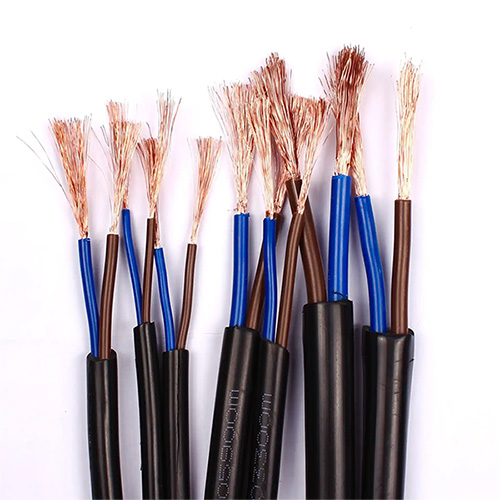
2025-09-19 10:58:41
Low Voltage Landscape Lighting Cable, often referred to as direct burial landscape wire, is a specialized Electrical Cable designed to operate outdoor lighting systems at a safe 12 or 24 volts. Its core characteristic is its construction for durability and safety in harsh outdoor environments. The cable typically features stranded copper conductors, which provide superior flexibility (allowing for bends with a minimum radius of approximately 5 times the cable diameter) and resistance to breakage from repeated movement or freezing ground. The number of conductors can vary, with 12/2 (12-gauge, 2 conductors), 14/2, 16/2, and multi-conductor cables like 12/7 being common; lower gauge numbers indicate thicker wires capable of carrying higher amperage over longer distances with less voltage drop. For instance, a 12-gauge cable can effectively run a 200-watt system up to 100 feet from the transformer with a voltage drop of less than 10%, a critical performance metric for maintaining lamp brightness. The conductors are heavily insulated with a thick layer of PVC or similar thermoplastic material, rated for wet locations and offering high dielectric strength to prevent current leakage. The entire assembly is then encased in a robust outer jacket that is resistant to moisture, abrasion, UV radiation, temperature extremes (typically rated for -40°C to 60°C or -40°F to 140°F), and degradation from soil chemicals and oils. This jacket is often a bright color like yellow for high visibility during installation. For direct burial applications, the cable must meet specific standards for burial depth (commonly 6 inches is sufficient) without the need for conduit, thanks to its waterproof design.

The primary application of this cable is, as the name implies, in low-voltage landscape lighting systems. Its use cases are diverse and critical to both aesthetic and functional outdoor design.
Residential Property Illumination
This is the most common use. The cable is snaked through gardens, under mulch beds, and along pathways to power LED or halogen spotlights that uplight trees and architectural features, well lights that illuminate shrubs, path lights that define walkways, and deck lights for safety and ambiance. The low voltage ensures safety for families and pets, even if the cable is accidentally nicked during gardening.
Commercial and Public Spaces
Hotels, restaurants, office parks, and municipal parks use this cable extensively for architectural lighting, signage accent lighting, and to safely illuminate pathways, steps, and ramps for patrons after dark. The durability of the cable is essential for withstanding higher foot traffic and commercial landscaping maintenance.
Security and Safety Lighting
Beyond aesthetics, the cable is used to power low-voltage lights that deter intruders by eliminating dark shadows around a property's perimeter. It is also crucial for lighting steps, uneven pathways, and water features like pools and ponds to prevent accidents, providing a safe environment without the high risk associated with standard line-voltage lighting near water.
Specialized Accent Lighting
The flexibility of smaller-gauge cables (like 16/2 or even 18/2) makes them ideal for intricate lighting projects, such as wrapping a string of fairy lights through a tree's branches or installing miniature lights within a masonry wall or under a railing.
Proper installation and minimal maintenance are key selling points of a quality low-voltage landscape lighting cable. However, a proactive approach ensures system longevity and optimal performance.
Installation Best Practices
The foundation of cable longevity is correct installation. Always bury the cable at the recommended depth (typically 6 inches) to protect it from lawn aerators, edgers, and shovels. When running cable above ground, such as under mulch or gravel, use landscape wire staples or stakes to secure it and prevent tripping hazards or damage from being moved. Avoid creating sharp kinks or bends during installation, as this can stress the internal conductors and lead to failure. Use waterproof Wire Connectors (often gel-filled) for all splices and connections to the light fixtures to prevent corrosion and short circuits from moisture ingress. Finally, ensure the cable is not pinched by rocks or other heavy objects that could compromise the jacket over time.
Routine Inspection
Conduct a visual inspection of the entire lighting system at least twice a year, typically in the spring and fall. Look for any sections of cable that may have become exposed due to soil erosion or animal activity. Check the jacket for any signs of damage, including cuts, abrasions, cracking, or chewing from rodents. Pay close attention to connection points, ensuring they remain sealed and free of corrosion.
Troubleshooting and Repair
If a section of the lighting system fails, the cable is often the culprit. Use a digital multimeter to check for continuity and voltage along the run to isolate the problem. If a break or severe damage is found, the best practice is to excavate that section and replace it with a new piece of the same gauge cable, using direct burial splice kits to create a permanent, waterproof repair. Never simply wrap damaged cable with electrical tape, as this is not a waterproof or long-term solution and creates a safety hazard. During the winter, if the system is not used, it is advisable to disconnect the transformer. While the cable is designed for cold weather, this prevents unnecessary wear on the entire system.
Preventative Measures
When planning new landscaping projects, always mark the cable's location with a detailed diagram or use warning tape buried slightly above the cable to alert future diggers. Keep the area around above-ground cable runs clear of dense vegetation that could trap moisture and accelerate jacket degradation. By following these simple maintenance steps, a quality low-voltage landscape lighting cable can provide reliable and safe operation for well over a decade, forming the hidden backbone of a beautiful and functional outdoor space.

Specializing in the production of wire and cable Hong Kong funded enterprises (both domestic and foreign sales); has won the IS09001-2000 international quality certification and the United States UL safety certification, is a professional wire manufacturers.
Tel: +86-769-8178 1133
Mobile: +86-13549233111
E-mail: 3285798314@qq.com
Add: No.13 Shui Chang Er Road, Shui Kou Village, Dalang Town, Dongguan City, Guangdong Province, China